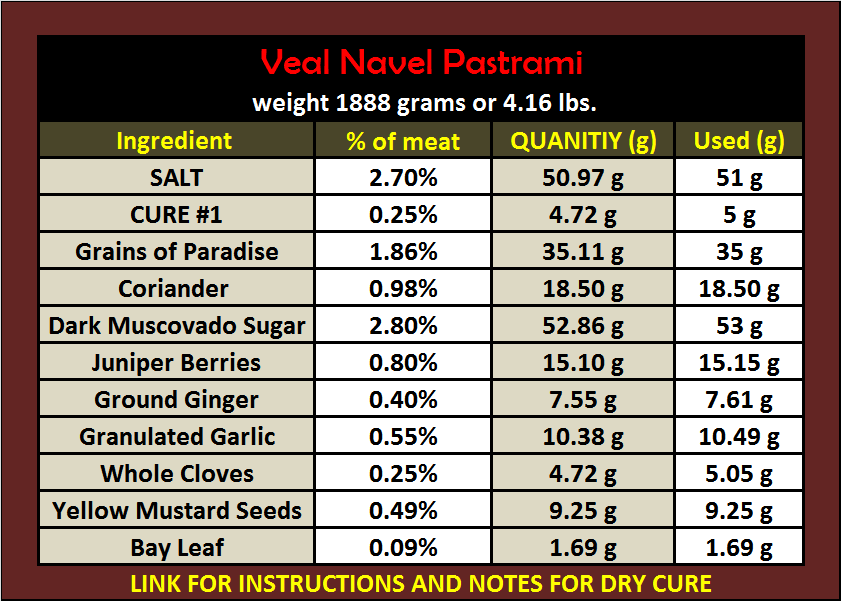Moulard Duckstrami
If you love beef pastrami you will love Duck pastrami. I chose Moulard Duck Breasts to make my Pastrami. My reasoning for choosing this Species of Duck was the percentage of duck fat it carries. A Muscovy duck breast has about 18% fat, the Peking duck breast has about 29% and the Moulard is a cross between the Muscovy and the Pekin. In a previous post I made Muscovy Duck Pastrami and it was the bomb. I wanted to try Moulard because they're bigger and have more fat. These babies are huge too (2900 grams and 6.39 lbs).
This recipe is almost identical to my other pastrami recipe with the exception to a tweak in salt and cloves quantities.
 The first thing I did was measure out all the ingredients and put them in separate bowls. As you can see I used percentages based on meat weight. This makes replicating recipes very easy. Two of my ingredients make this Pastrami I think very unique.
The first thing I did was measure out all the ingredients and put them in separate bowls. As you can see I used percentages based on meat weight. This makes replicating recipes very easy. Two of my ingredients make this Pastrami I think very unique. I also used Dark Muscovado Sugar instead of Brown sugar. It's a molasses sugar that is very moist and gets its unique flavor from sugarcane juice. The other ingredients are pretty common. I decided to use a combination of spices that are common with both Beef and duck. Heck this is just an experiment.
 The first thing I did was combine the Salt and cure #1 together and coat both sides of the Duck Breast rubbing it into every nook and cranny. Next I combined the rest of the ingredients and thoroughly coated both sides of Duck Breast.
The first thing I did was combine the Salt and cure #1 together and coat both sides of the Duck Breast rubbing it into every nook and cranny. Next I combined the rest of the ingredients and thoroughly coated both sides of Duck Breast.I used equilibrium curing instead of excess salt curing. Excess salt curing is a technique where you cover the meat entirely in salt.
Equilibrium curing is using exact amounts needed for the cure.
"This method would be the Sous-Vide cooking of the curing world". Jason Molinari

Procedures after the curing process. Remove breast from bag and rinse under cold water removing as much as the cure as you can.
Pat dry and apply Rub .
 |
| mixed up and ready to go.... |
Place the Grains of Paradise, Coriander, Juniper Berries, and Cloves (if using whole) and grind in a spice grinder. Apply Rub to both sides of the Duck.
Place Duck breast in smoker. I cold smoked the breasts at the ambient temp outside using Apple pellets for about 2 1/2 hours. I used a cold smoking device called A-MAZE-N-PELLET-SMOKER.
 After the cold smoking process I hot smoked the breast using charcoal and apple wood. Starting at a very low temp below 175 and bring it up to about 225 degrees. I will smoke the duck breasts until an internal temp of 135 degrees is reached.
After the cold smoking process I hot smoked the breast using charcoal and apple wood. Starting at a very low temp below 175 and bring it up to about 225 degrees. I will smoke the duck breasts until an internal temp of 135 degrees is reached. Note: the breasts internal temp ranged form 133-143 because of placement in smoker and size of breast.
 |
| Vacuumed Sealed |
After they are done smoking I will Sous-Vide the breasts for 3 hours at 137 degrees to tenderize them. As you can tell from the picture they are beautiful and developed a great bark.


Floating in a thermal bath getting tenderized.
Final thoughts- Textually different from the Muscovy Breasts and very meaty. Not as delicate as the Muscovy Breasts but still over the top as far as Duckstrami goes. I will be making this again.
Now for the gratuitous photographs.
.jpg)
























































